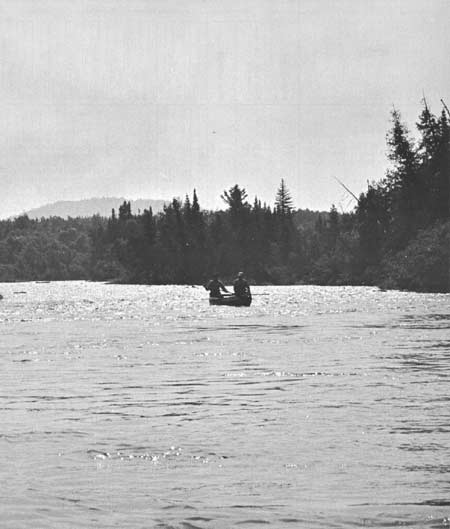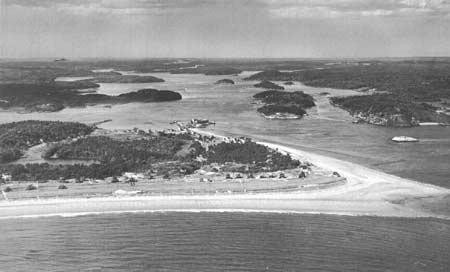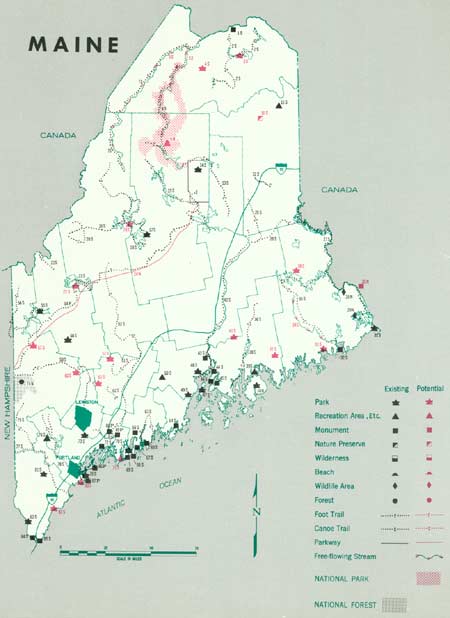.gif)
Parks for America
MENU
|
Parks for America
|

|

|
| The Allagash River region of northwestern Maine is still an unspoiled country of adventure. A national river including the waterway and its headwater lakes has been proposed to preserve the area's wilderness character. |
MAINE
MAINE has an abundance of lakes, mountains, rivers, forests, and a rugged and varied coast line that has made it a vacationland for much of the eastern seaboard.
The State's population in 1960 was 969,265, a 6-percent increase over 1950. Fifty-one percent was urban. The projected population for 1976 is 1,069,000. There was an average of 31 persons per square mile, ranging from 4 in Piscataquis County, center of the Maine wilderness, to 314 in Cumberland County, which includes the city of Portland.
Lumbering and the manufacture of wood products are Maine's principal industries. Agriculture is next in importance, with major emphasis on potatoes, dairy products, and poultry. The tourist industry follows, making it one of the major revenue-producing activities in the State.
State roads are extensive in the southwestern part of the State, fewer in the north. All are adequate and most are scenic. It is estimated that 93 percent of the recreation seekers enter Maine by automobile. The Interstate System when completed may hurry travelers through to Canada, but it will also make much of eastern and northern Maine more accessible.
Lakes, mountains, rivers, forests, abundant fish and wildlife, a long and scenic coastline, and the largest wilderness area remaining in the East comprise Maine's important recreation resources. Hunting in the fall, winter sports, inland- and deep-water fishing, and, in summer, boating, swimming, camping, mountain climbing, hiking, and horseback riding can be enjoyed in fullest measure. Many rivers are particularly suited for canoe trips and true wilderness experiences are possible in several areas.
Maine has many survivals of its colorful history from the Anglo-French struggle for control of the fur trade and fisheries, through the Indian wars, the Revolution, and War of 1812, and into the economic and cultural evolution of the modern State. The Lady Pepperrell House at Kittery Point possesses exceptional value in commemorating a phase of our history.
EXISTING PUBLIC AREAS
NATIONAL: The National Park Service administers 1 national park of 28,619 acres with a 1960 visitation of 1,638,000. There is one national forest of 41,004 acres with four recreation areas. The Bureau of Sport Fisheries and Wildlife has one national wildlife refuge of 22,566 acres with one recreation area.
STATE: Five agencies of the State administer a variety of areas: The Park Commission administers 17 parks of 15,576 acres and 15 historic sites of 230 acres. These had a combined 1960 attendance of 630,508. The Baxter State Park Authority administers a wilderness park of 193,254 acres, with 60,611 visits recorded in 1960. The State Forest Service maintains 260 campsites and 89 picnic grounds in its operation. There are 14 game management areas comprising 17,400 acres under the Inland Fish and Game Department.
LOCAL: No major nonurban local areas were identified.
QUASI-PUBLIC AND PRIVATE: Maine has 269 miles of the Appalachian Trail. Four historic monuments are of State or National significance.
PRIVATE: Private enterprise provides most of the services and accommodations for tourists and in-State vacationists. Inns, hotels, motels, cabins, resident camps and family campgrounds are located throughout the State. Private campgrounds are of increasing importance. Many sporting camps for hunters and fishermen are situated in the more remote regions. Ski areas and extensive lakeshore cottage developments are on the increase. Bush pilots provide plane service into the back country. There are numerous guides catering to the sportsmen.
PARK AND RELATED NEEDS
Protection of key wild areas to insure retention of the "North Country" atmosphere is essential. There is need for preservation of certain free-flowing streams to insure a continuation of the natural values associated with streams in a relatively undisturbed setting. This is true also of some of Maine's best lakes and ponds still largely in a natural condition. Permanent easements for the Appalachian Trail are needed. There is need also for an expanded program of waysides and identification of scenic routes.
Further exploratory and development work is advisable to make the most of the State's rich historical resources. Moreover, the charming early New England atmosphere of Maine's villages and maritime and rural scenes is important and should be protected. Effective cooperation by State and local authorities is needed to provide such controls as zoning, scenic easements, and billboard regulation.
Although the State currently administers 209,060 acres in parks and related areas, the types and distribution are not balanced to meet 1976 needs. Meeting the demand for day- and weekend-use areas in the southern part of the State and the vacation needs throughout the State calls for expansion of present facilities and acquisition of areas of scenic and scientific interest, as well as areas suitable for water-based recreation along the coastline and the shorelines of lakes and streams. The 35,580 acres of potential and suggested areas shown in the tabulation should be acquired to correct this imbalance, and to furnish adequate recreation lands for an expanding population and the ever-increasing use by visitors to the State.

|
| Near Popham Beach, an important seashore area in Maine, England first attempted a New England colony. Fort Popham close by dates from Civil War times. |
RECOMMENDATIONS
Existing recreation resources and many potential areas are shown on the accompanying tabulation and map. The following recommendations, if implemented by vigorous action on the part of the agencies concerned, may help to realize outdoor recreation opportunities needed for public enjoyment and use.
NATIONAL: Establishment of the Allagash National River. Establishment of St. Croix Island National Monument as authorized by Congress. Further study on the Maine portion of the suggested Appalachian Parkway.
STATE: Expansion of the State park system to preserve valuable resources by the addition of nine park and two recreation areas, with further study of two parks, one recreation area, and one nature preserve. Designation and protection of two free-flowing stream and further study on one additional stream.
Supporting recommendations include:
1. Consideration should be given to working out cooperative methods between private owners and local and State public agencies that would combine timber management and production with recreational development and use.
2. Development of waysides along the Interstate Highway System to keep pace with highway construction.
3. Acquisition of permanent easements along the Appalachian Trail.
4. A statewide comprehensive archeologic and historic site survey to preserve and develop those site found to possess sound educational and inspirational values.
5. Legislative support is suggested for encouraging the cooperative efforts of local governments toward acquiring and developing lands for local nonurban recreation use.
(Table omitted from online edition)

|
| (click on image for an enlargement in a new window) |
NEXT >>>
|
|
Last Modified: Mon, Sep 6 2004 10:00:00 pm PDT
parks_america/maine.htm
 Top
Top